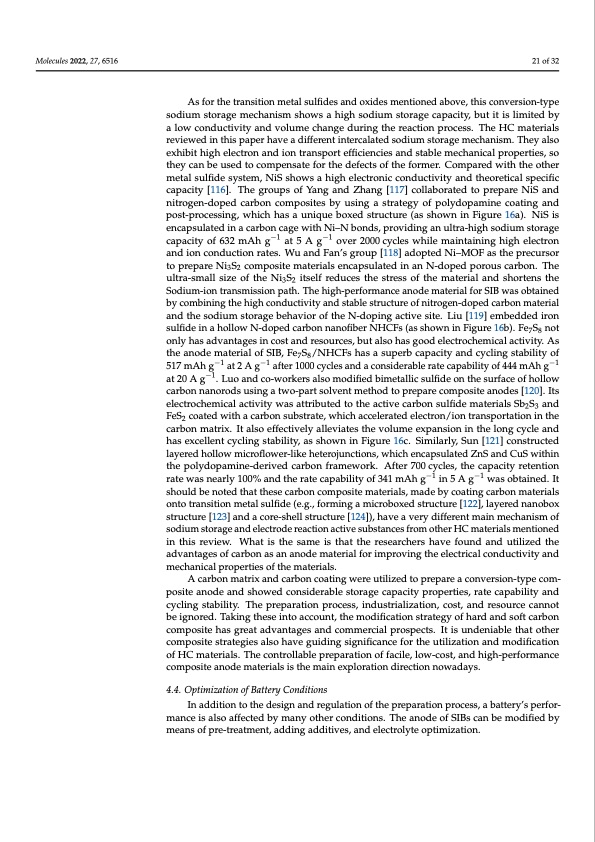
PDF Publication Title:
Text from PDF Page: 021
Molecules 2022, 27, 6516 21 of 32 As for the transition metal sulfides and oxides mentioned above, this conversion-type sodium storage mechanism shows a high sodium storage capacity, but it is limited by a low conductivity and volume change during the reaction process. The HC materials reviewed in this paper have a different intercalated sodium storage mechanism. They also exhibit high electron and ion transport efficiencies and stable mechanical properties, so they can be used to compensate for the defects of the former. Compared with the other metal sulfide system, NiS shows a high electronic conductivity and theoretical specific capacity [116]. The groups of Yang and Zhang [117] collaborated to prepare NiS and nitrogen-doped carbon composites by using a strategy of polydopamine coating and post-processing, which has a unique boxed structure (as shown in Figure 16a). NiS is encapsulated in a carbon cage with Ni–N bonds, providing an ultra-high sodium storage capacity of 632 mAh g−1 at 5 A g−1 over 2000 cycles while maintaining high electron and ion conduction rates. Wu and Fan’s group [118] adopted Ni–MOF as the precursor to prepare Ni3S2 composite materials encapsulated in an N-doped porous carbon. The ultra-small size of the Ni3S2 itself reduces the stress of the material and shortens the Sodium-ion transmission path. The high-performance anode material for SIB was obtained by combining the high conductivity and stable structure of nitrogen-doped carbon material and the sodium storage behavior of the N-doping active site. Liu [119] embedded iron sulfide in a hollow N-doped carbon nanofiber NHCFs (as shown in Figure 16b). Fe7S8 not only has advantages in cost and resources, but also has good electrochemical activity. As the anode material of SIB, Fe7S8/NHCFs has a superb capacity and cycling stability of 517 mAh g−1 at 2 A g−1 after 1000 cycles and a considerable rate capability of 444 mAh g−1 at 20 A g−1. Luo and co-workers also modified bimetallic sulfide on the surface of hollow carbon nanorods using a two-part solvent method to prepare composite anodes [120]. Its electrochemical activity was attributed to the active carbon sulfide materials Sb2S3 and FeS2 coated with a carbon substrate, which accelerated electron/ion transportation in the carbon matrix. It also effectively alleviates the volume expansion in the long cycle and has excellent cycling stability, as shown in Figure 16c. Similarly, Sun [121] constructed layered hollow microflower-like heterojunctions, which encapsulated ZnS and CuS within the polydopamine-derived carbon framework. After 700 cycles, the capacity retention rate was nearly 100% and the rate capability of 341 mAh g−1 in 5 A g−1 was obtained. It should be noted that these carbon composite materials, made by coating carbon materials onto transition metal sulfide (e.g., forming a microboxed structure [122], layered nanobox structure [123] and a core-shell structure [124]), have a very different main mechanism of sodium storage and electrode reaction active substances from other HC materials mentioned in this review. What is the same is that the researchers have found and utilized the advantages of carbon as an anode material for improving the electrical conductivity and mechanical properties of the materials. A carbon matrix and carbon coating were utilized to prepare a conversion-type com- posite anode and showed considerable storage capacity properties, rate capability and cycling stability. The preparation process, industrialization, cost, and resource cannot be ignored. Taking these into account, the modification strategy of hard and soft carbon composite has great advantages and commercial prospects. It is undeniable that other composite strategies also have guiding significance for the utilization and modification of HC materials. The controllable preparation of facile, low-cost, and high-performance composite anode materials is the main exploration direction nowadays. 4.4. Optimization of Battery Conditions In addition to the design and regulation of the preparation process, a battery’s perfor- mance is also affected by many other conditions. The anode of SIBs can be modified by means of pre-treatment, adding additives, and electrolyte optimization.PDF Image | Hard Carbons as Anodes in Sodium-Ion Batteries

PDF Search Title:
Hard Carbons as Anodes in Sodium-Ion BatteriesOriginal File Name Searched:
molecules-27-06516-v2.pdfDIY PDF Search: Google It | Yahoo | Bing
Salgenx Redox Flow Battery Technology: Salt water flow battery technology with low cost and great energy density that can be used for power storage and thermal storage. Let us de-risk your production using our license. Our aqueous flow battery is less cost than Tesla Megapack and available faster. Redox flow battery. No membrane needed like with Vanadium, or Bromine. Salgenx flow battery
| CONTACT TEL: 608-238-6001 Email: greg@salgenx.com | RSS | AMP |